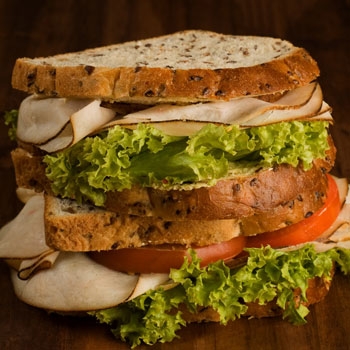 by Ginger Voight
by Ginger Voight
In our Super Size world, it can be easy for us to lose track of how to portion our food. Promises of "all you can eat" for pennies more than you'd pay for smaller quantities tantalize not only the taste buds but those seeking a bargain. Unfortunately this can ultimately pay off with larger waistlines and health problems from overindulgence.
Simply put: people now eat more than they need to eat.
According to the Children's Research Center, portion sizes (and their caloric content) have increased dramatically.
A serving of soda used to be around six ounces and 85 calories. Now that same soda is 20 ounces and three hundred calories.
A simple bagel used to be three inches in diameter and ran about 140 calories. Now they are five to six inches in diameter and weigh in at 350 calories or higher.
A serving of pasta has doubled from two to four cups, making the calories double from 280 to over 560 - and that is without calculating sauce or fats used in cooking.
That super size French fry bargain? Those extra few cents could cost you more than a hundred calories. If you really want to save your money, try going for the small serving instead. At McDonald's a small serving of French fries is 230 calories, whereas a large is a whopping 500 calories and more than double the fat.
Even our dinner plate, which used to measure ten inches in diameter has increased to twelve and a half inches in diameter. Add this to increased "super size" portions in restaurants, larger muffin or baking tins and larger soda containers and you can take in additional calories in every serving, which adds up to increased weight.
It's become such a problem that many people wouldn't be able to identify a proper serving of food.
For a quick visual aid, here's how normal servings of the following foods would look, according to the Baylor College of Medicine:
One cup of food = a baseball or woman's fist. This would include your fresh greens, yogurt, a medium piece of fruit or a baked potato.
One half cup of food = a rounded handful. This would be how you'd measure cut fruit, cooked vegetables, pasta or rice. This also equals one ounce of food such as snack foods, such as pretzels.
One fourth cup of food = a large egg. Use this visual tool to measure your dried fruit, like raisins.
Three ounces of food = a cassette tape. With this tool you can measure your meat or poultry.
Three ounces of food = your checkbook. Use this visual tool to measure your serving of fish.
One and a half ounces of food = six dice. This would include foods like natural cheeses.
One ounce of food = one die. Use this to measure some of your solid fats, such as margarine or spreads.
One tablespoon = your thumb tip. This will cover your liquid fats, like oils and mayonnaise.
But just knowing what a serving size looks like isn't always enough. Researchers have shown that simply buying a larger size quantity than what you need in something like a bag of potato chips can mean you eat more than the designated serving in one sitting.
So here are some tips to avoid portion distortion pitfalls.
Whenever you go to a fast food restaurant, avoid the temptation to pay a few cents more for the super size quantities. As stated above, you can save even more money by "down" sizing your meal.
At sit down restaurants, tell the waiter to only bring out half of the serving for you to eat at the table, and box the rest for you to take home. You could also share your meal with a friend.
When you go to the grocery store, take a moment to read the labels of the products you buy, and only buy that which you need. If you're buying spaghetti to make for your family of four, don't buy the package that equals eight servings. If do you end up buying the larger economy sizes, be sure to repackage them as soon as you get home; portioning it out into the proper serving sizes for convenient use later.
Buy or eat off of smaller plates. This is a pretty big visual aid in and of itself. You'll see a full plate, but in effect you're actually eating less.
With a little thought and preparation, you can free yourself from portion distortion and save yourself extra pounds, as well as money, and your health.